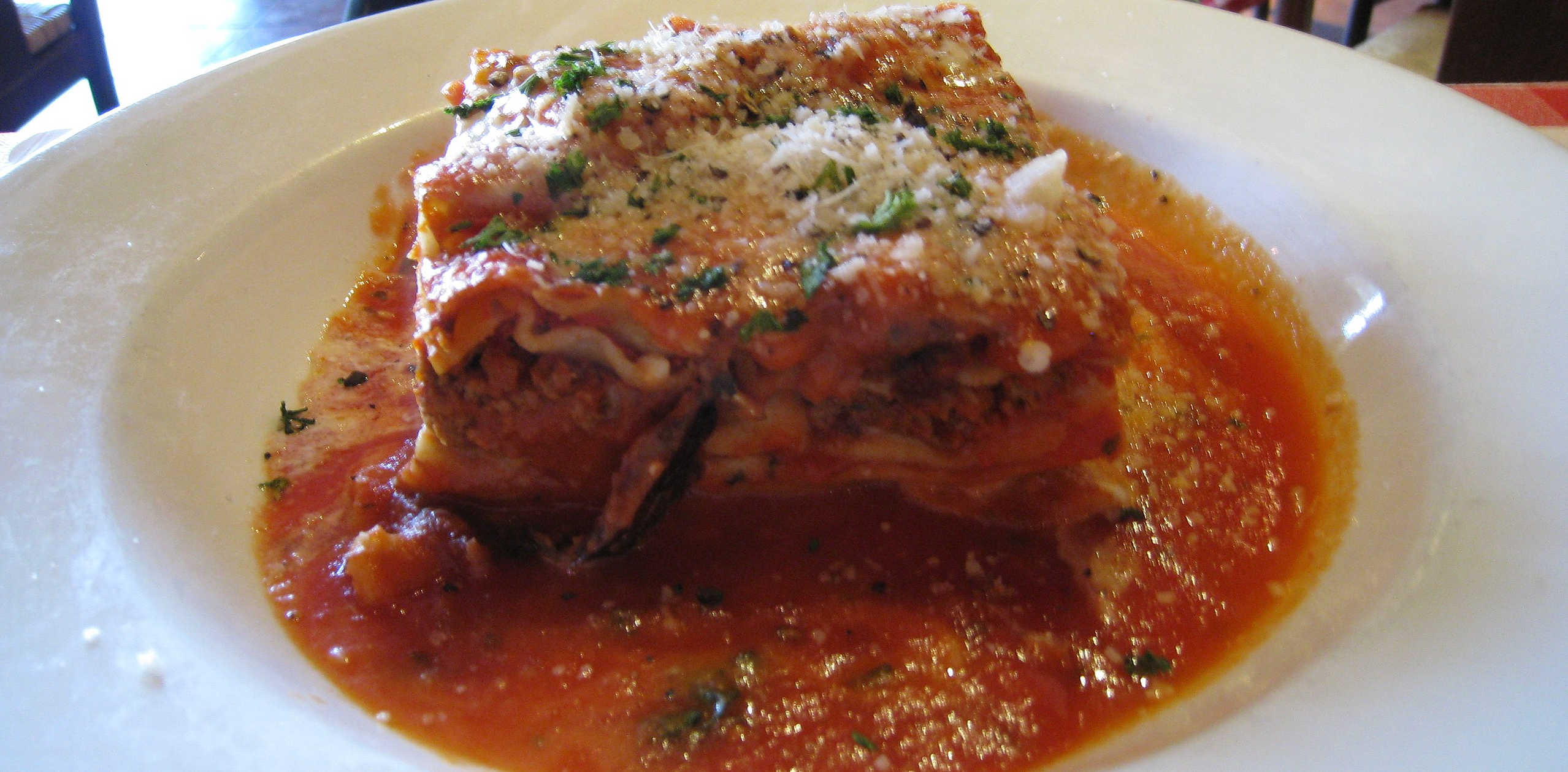Lasagna
Peter Flynn
 🔗
🔗I’m using the US name for this dish (Lasagna) but the Italian word for the actual pasta (lasagne).
The way I was taught to make a Lasagna didn’t involve either celery or carrot, but after looking through a lot of recipes, it’s clear it should have. So here’s the revised version, scaled up a little: this makes enough for three layers in one very large baking dish. You will need a big casserole dish or very large frying pan with a cover to cook the ragù.
Your support for our advertisers helps cover the cost of hosting, research, and maintenance of this site
Ingredients
Ragù
- 2 sticks celery
- 1 medium carrot
- 2 medium onions
- 2 large cloves garlic
- 3 bay leaves
- 2 sprigs rosemary
- 1 tsp dried oregano
- 4 tbsp olive oil
- 1 Kg minced beef
- 100 ml beef stock (or 2 stock cubes and some water)
- 2 × 400 g tin chopped tomatoes
- ½ tubes tomato purée
Béchamel
- 1 ℓ milk
- 1 tbsp black peppercorns
- 1 tsp dried, mixed herbs [Italian herbs or herbes de Provence]
- 100 g butter
- 2 tbsp heaped flour
Lasagna
- 15 sheets dried lasagne (or fresh if you can get or make it)
- 50 g parmesan
If you have the kind of lasagne that says it can be used without pre-boiling, make sure your ragù is wetter than normal (add a bit more stock if it's too dry). If you’re using fresh lasagne, measure what you need (see below).
Method
Ragú
Slice and chop the celery and carrot very small indeed (fine brunoise dice if you have a machine or cutter).
Chop the onion and garlic very small.
Heat half the oil in a wide pan and fry the vegetables gently until they soften and start to caramelise.
Drain them out into the casserole and set aside, keeping the oil in the pan.
Heat the rest of the oil in the pan and cook the mince, stirring it to break it up;
I do this in two batches because it’s easier to control.
Add the beef stock once the meat starts to get wet, and continue stirring and frying until it starts to brown.
When it’s all mixed well, add the tomatoes and tomato purée and bring back to the boil.
Add it all to the vegetables in the casserole, mix well, and put in the oven with the lid on for about 30 and a bit minutes at 200°C.
Mary Berry recommends stopping after this stage and leaving the meat mix to cool completely. So do I.
Béchamel
Gently heat the milk with the peppercorns and herbs until it almost starts to boil.
Strain through a sieve into a jug (discard the peppercorns and herbs).
In the saucepan, melt the butter and then stir in the flour.
Mix and cook gently for about half a minute then turn off the heat or move the saucepan off the ring.
Add about 50ml of the milk (half a coffee-cup, a very small quantity) and mix vigorously.
The mix will start to form a stiff dough, like choux pastry.
Add the same amount of milk and repeat.
And again.
Keep doing this until the dough becomes a sauce. You can add slightly more milk at each stage. Depending on your flour, you may not need all the milk: stop before the sauce gets too thin.
Bring back to the boil stirring all the time, then pour it into the jug (remove any unused milk first!).
Lasagne (dried type needing pre-cooking)
Boil your biggest pan three-quarters full of water.
Drop in the sheets of lasagne one by one.
Stir gently to stop them sticking together but don’t break them up.
After five minutes, tip out the water very carefully, and fill the pan up with cold water.
When you can handle the lasagne, lift out the sheets onto a clean drying-cloth (linen or cotton) laid out flat, and keep the sheets separate.
Assembly
You need enough lasagne sheets to cover the size of your baking dishes three times: once for each layer. Don't forget cooked lasagne will have swelled, so it will be bigger when cooked than when you measured it dry;
With pre-cooked lasagne, I find a pizza-cutter works well for trimming the sheets against the edge of the baking dish.
With dry lasagne, you have to be very careful if you need to break bits off the dry sheets to make them fit, otherwise the whole sheet will splinter into shards.
With fresh lasagne, use scissors to trim the pieces to fit the dish.
Eyeball the ragù and the sauce so you can judge what one-third of the quantity is. If you’re using this recipe to fill two smaller dishes, you may want to divide the ragù, sauce, and lasagne into two batches before you start assembly.
Start by putting a layer of ragú in the bottom of the dish and levelling it. Use one-third of the available ragú on each layer.
Lay some lasagne sheets on top, fitting them together in a single layer so that the ragú is all covered.
Pour some béchamel on top and smooth it out with the back of a spoon so that the lasagne is all covered.
Now repeat the three layers, and then repeat again. The dish should now be full and you will be out of ingredients.
Cooking
Sprinkle the top of the béchamel with grated parmesan.
Put in the over at 180°C for 30 and a bit minutes or until the top is golden brown.
Your support for our advertisers helps cover the cost of hosting, research, and maintenance of this site